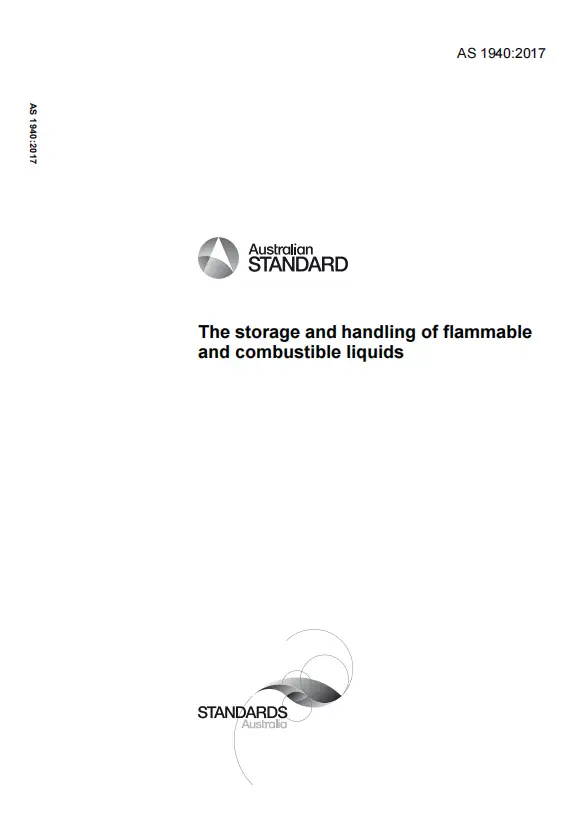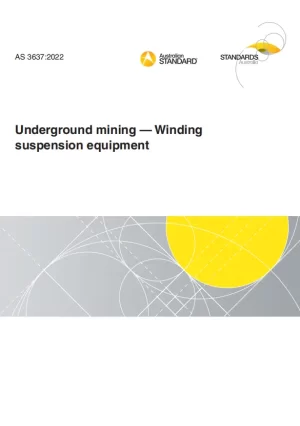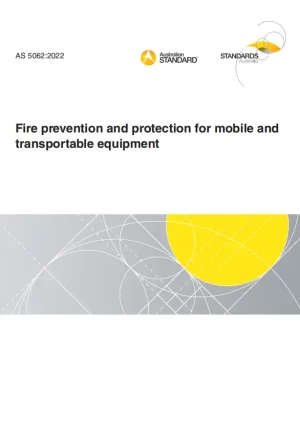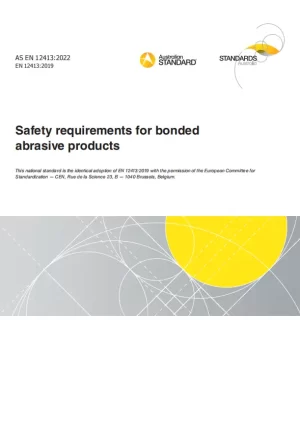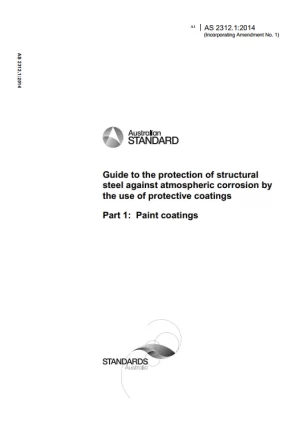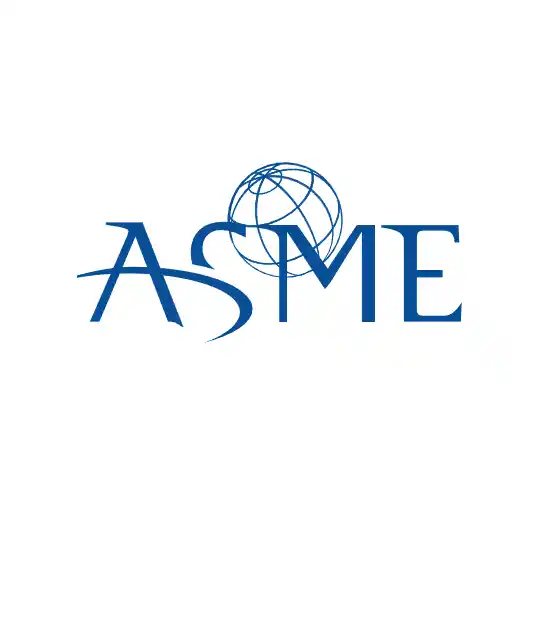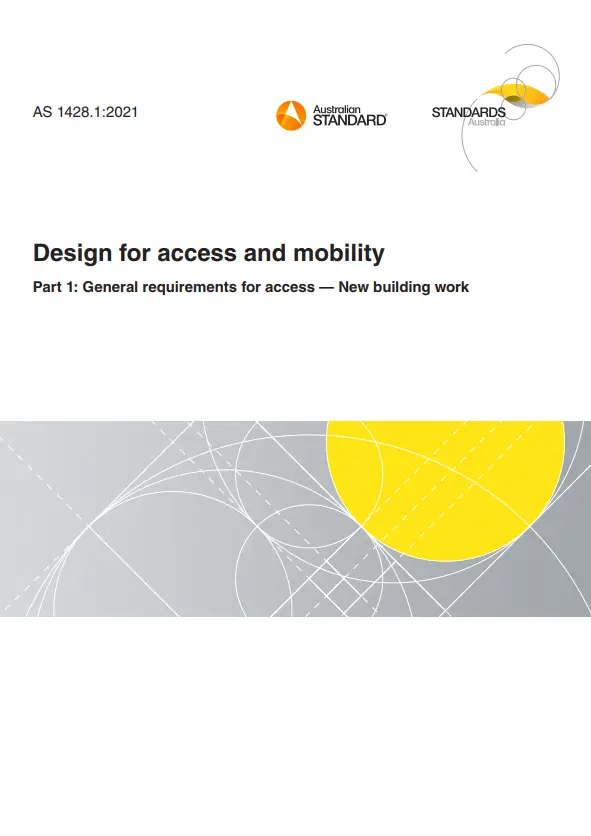AS 1940, 6th, 2017 – The storage and handling of flammable and combustible liquids
AS 1940 sets out requirements and recommendations for the safe storage and handling
of flammable liquids of dangerous goods Class 3, as classified in the UN Recommendations
for the Transport of Dangerous Goods—Model Regulations and listed in the ADG Code.
This Standard also provides requirements and recommendations for the storage and
handling of combustible liquids, as defined in Clause 1.4.9.
This Standard provides minimum acceptable safety requirements for storage facilities,
operating procedures, emergency planning and fire protection. It provides technical
guidance that may assist in the storage and handling of flammable and combustible liquids
in accordance with the risk management requirements of Safe Work Australia, Model Code
of Practice, Managing Risks of Hazardous Chemicals in the Workplace and legislation
which underpins that document.
This Standard provides requirements for commonly used flammable and combustible
liquids such as hydrocarbons and industrial solvents. Some flammable and combustible
liquids have other physical and chemical properties that require additional precautions and
design considerations. Examples of these are—
(a) liquids that can polymerize;
(b) liquids that require blanketing with inert gas;
(c) liquids that are heated; and
(d) liquids that are assigned a subsidiary risk.
Any special precautions and considerations necessary for the safe storage and handling of
such liquids are additional to the requirements and recommendations provided in this
Standard.
For the storage and handling of dangerous goods of another class but having a Class 3
subsidiary risk, this Standard is relevant to their flammability aspects.
NOTE: Fuel blends that contain biofuel (e.g. ethanol) have physical and chemical properties that
require additional precautions and design considerations.
General Product Information:
| Committee |
ME-017 |
| Purchase Note |
All current amendments available at time of purchase are included with the purchase of this document |
| Document Type |
PDF |
| ISBN |
978 1 76035 857 0 |
| Pages |
170 |
| Document Language |
English |
| Publisher |
Standards Australia |
| Status |
Current |
Preview
Table of cotents
1 Scope and general
1.1 Scope
1.2 Application
1.2.1 Where this Standard applies
1.2.2 Where this Standard does not apply
1.3 Normative references
1.4 Definitions
2 Minor storage
2.1 Scope of section
2.2 Minor storage quantities
2.2.1 Quantities allowable as minor storage
2.2.2 Quantities of Packing Group I
2.2.3 Multiple minor storages
2.2.4 Separation between minor storage and other stores
2.2.5 Minor storage on open land
2.2.5.1 General
2.2.5.2 Polyethylene or composite storage tanks for minor storage
2.2.6 Minor storage on construction sites
2.3 Precautions applying to minor storage
2.3.1 Location of minor storage
2.3.2 Operations
2.3.3 Control of ignition sources (flammable liquids only)
2.3.4 Spillage control
2.3.5 Fire protection and warning signs
2.4 Minor storage in tanks
2.4.1 Construction
2.4.2 Installation
2.4.3 Maintenance
3 General requirements
3.1 Scope of section
3.2 General design and construction requirements
3.2.1 Design safety and suitability
3.2.2 Emergency provisions
3.2.3 Minimization of vapour hazards
3.2.4 Ignition sources
3.2.5 Separation distances
3.2.5.1 General
3.2.5.2 Separation to property boundary
3.2.5.3 Separation to protected places on adjoining properties
3.2.5.4 Adjacent occupancies storing flammable and combustible liquids
3.2.5.5 On-site storage of other dangerous goods
3.3 Mechanical equipment and installations
3.4 Electrical installations and equipment
3.5 Internal combustion engines
3.6 Lighting
3.7 Restricted usage
3.8 Firewalls and vapour barriers
3.8.1 Conditions of use
3.8.2 Construction of firewalls
3.8.3 Construction of vapour barriers
3.9 Security, signs and notices
3.9.1 Control of access
3.9.2 Signs and notices
3.10 Transit storage
3.10.1 General
3.10.2 Delineation of transit storage areas
3.10.3 Requirements for transit storage
3.10.4 Separation distances
3.11 Ignition sources
4 Package storage and handling areas
4.1 Scope of section
4.2 Types of stores
4.3 Location and separation distances
4.3.1 Separation distances for package stores
4.3.2 Protection of elevated protected places
4.3.3 Location of internal package stores
4.4 Construction
4.4.1 General construction
4.4.2 Construction of internal or attached package stores
4.4.3 Spillage containment
4.4.4 Doors
4.4.4.1 General
4.4.4.2 Use of non-fire rated doors
4.4.5 Windows in fire-rated walls
4.5 Ventilation
4.5.1 General ventilation requirements
4.5.2 Additional ventilation requirements for package handling, filling and decanting areas
4.5.3 Vent protection
4.5.4 Natural ventilation
4.5.4.1 General
4.5.4.2 Vent size and location
4.5.4.3 Natural ventilation for package stores containing combustible liquids only
4.5.5 Mechanical ventilation
4.6 General requirements
4.7 Storage of IBCs
4.8 Storage in freight containers
4.9 Storage in storage cabinets
4.9.1 General
4.9.2 Cabinet construction
4.9.3 Additional construction requirements for cabinets exceeding 250 L capacity
4.9.4 Cabinet marking
4.9.5 Ventilation provisions
4.9.6 Cabinet location
4.9.7 Exclusion of ignition sources
4.9.8 Storage in storage cabinets
4.10 Activities within package stores
4.11 Offices within package stores
5 Storage in tanks
5.1 Scope of section
5.2 General requirements
5.2.1 Design and construction of static storage tanks
5.2.2 Markings
5.2.3 Change of tank contents
5.2.4 Pipework
5.2.5 Roofs over tanks
5.2.6 Tanks on or above a roof
5.3 Storage tank fill points
5.3.1 Fill connection
5.3.2 Location of fill point
5.3.3 Liquid level indication
5.3.4 Filling of elevated tanks
5.4 Venting
5.4.1 General requirements
5.4.2 Vent capacity
5.4.3 Vent piping
5.4.4 Vent outlet location
5.4.5 Vent terminals
5.4.6 Application of pressure-vacuum vents
5.4.7 Setting of pressure-vacuum vents
5.5 Emergency venting
5.5.1 Application of emergency venting
5.5.2 Capacity and size of emergency vents
5.5.3 Pressure setting of emergency vents
5.6 Location and capacity of indoor tanks
5.6.1 General
5.6.2 Flammable liquids
5.6.3 Class C1 liquids
5.6.3.1 Tanks having a capacity of 1000 L or less
5.6.3.2 Tanks having a capacity greater than 1000 L
5.6.4 Class C2 liquids
5.7 Separation of above-ground tanks
5.7.1 Application
5.7.2 Separation distance from tank to protected places, security fences or to on-site protected places
5.7.3 Distance between vertical tanks for flammable liquids
5.7.4 Distance between vertical tanks for combustible liquids
5.7.5 Clusters of tanks
5.7.6 Horizontal tanks
5.7.7 Mixed products
5.8 Bunds and compounds
5.8.1 Requirements
5.8.2 Capacity
5.8.3 Design and construction
5.8.4 Compound subdivision
5.8.5 Total storage per compound
5.8.6 Compound drainage
5.8.7 Management of fire water
5.9 Requirements for above-ground tanks with integral secondary containment
5.9.1 General
5.9.2 Requirements for all tanks having integral secondary containment
5.9.3 Additional requirements for double-walled tanks
5.9.4 Additional requirements for tanks with external fire-rated covering
5.9.5 Additional requirements for tanks with integrated spillage compounds
5.10 Requirements for tank containers (ISO tanks, portable tanks) including IBCS when used as static storage tanks
5.11 Installation methods for above-ground tanks
5.11.1 Foundations
5.11.2 Supporting structures
5.11.3 Tank bearing area
5.11.4 Tanks in areas subject to flooding
5.12 Installation methods for underground tanks
5.12.1 Method of installation
5.12.2 Access pits
5.12.3 Separation between tanks
5.12.4 Proximity to property boundaries
5.12.5 Proximity to foundations
5.12.6 Secondary containment
5.12.7 Corrosion protection
5.13 Installation methods for tanks in tank chambers
5.13.1 Above-ground tank chambers
5.13.2 Underground tank chambers
5.13.3 Backfilled chambers
5.14 Service tanks
5.14.1 Use of service tanks
5.14.2 Service tank higher than storage tank
5.14.3 Storage tank higher than appliance
5.14.4 Return systems
5.14.5 Service tanks indoors
6 Systems for piping, valves, pumps and tank heating
6.1 General design and construction
6.1.1 Design suitability
6.1.2 Material suitability
6.2 Piping
6.2.1 Design and construction
6.2.2 Joints
6.2.3 Flexible tubing
6.2.4 Transfer hose
6.2.5 Vapour recovery piping
6.3 Valves
6.3.1 System requirements
6.3.2 Emergency shut-off provisions
6.3.3 Valve selection
6.4 Pumps
6.4.1 Pressure and temperature control
6.4.2 Emergency shut-off
6.4.3 Pump drive
6.5 Heating of liquids
6.5.1 Access for service
6.5.2 Condensate
6.5.3 Heating of pipes
6.5.4 Heater controls
6.5.5 Temperature limits
6.5.6 Temperature monitoring
7 Fuel dispensing
7.1 Scope of section
7.2 General requirements
7.2.1 Storage method
7.2.2 High-level tanks
7.2.3 Gaseous fuels
7.2.4 Emergency power cut-off
7.2.5 Signs
7.2.6 Hazardous areas
7.3 Dispensers
7.3.1 General
7.3.2 Location
7.3.3 Drainage
7.3.4 Dispenser bypass
7.3.5 Remote pumping systems
7.3.6 Unsupervised self-service systems
7.3.7 Supervised self-service systems
7.4 Delivery hoses and nozzles
7.4.1 Nozzle design
7.4.2 Customer-operated nozzles
7.4.3 Conductivity
7.4.4 Hose assembly
7.5 Marine dispensers
7.5.1 Application
7.5.2 Pipework
7.5.3 Location
7.5.4 Nozzle
7.5.5 Instructions
7.6 Operations
7.6.1 Records
7.6.2 Procedures
7.6.3 Filling of containers with flammable liquids at dispensers
7.6.4 Filling of containers with combustible liquids at dispensers
8 Tank vehicle loading facilities
8.1 Scope of section
8.2 General requirements
8.2.1 Transfers
8.2.2 Location of fill point
8.2.2.1 Separation from above-ground tanks
8.2.2.2 Separation from protected places
8.2.2.3 Separation from package stores
8.2.2.4 Separation from on-site protected places, ignition sources and security fences
8.2.3 Building requirements
8.2.4 Collision protection
8.2.5 Vehicle access
8.2.6 Spillage control
8.2.6.1 General requirements
8.2.6.2 Capacity of spillage control system
8.2.6.3 Drainage
8.2.7 Flow rates
8.2.8 Emergency shut-down
8.2.9 Earthing and bonding
8.2.10 Bond wire connection
8.2.11 Monitored cable connection
8.3 Top-filling installations
8.3.1 Access to vehicle tank
8.3.2 Open-hatch filling
8.3.3 Tight-connection filling
8.4 Bottom-loading facilities
8.4.1 System design
8.4.2 Compliance with API Code
8.4.3 Design pressure
8.4.4 Flow rates
8.4.5 Overfill protection
8.4.6 Internal valve and vent control
8.4.7 Data collection
8.4.8 Atmospheric venting
9 Operational and personnel safety
9.1 Scope of section
9.2 General precautions
9.2.1 Control of entry
9.2.2 Clear access
9.2.3 Vehicular access in restricted areas
9.2.4 Vehicular access into a compound
9.2.5 Access by locomotives
9.2.6 Lighting
9.2.7 Control of ignition sources
9.2.7.1 Introduction of ignition sources
9.2.7.2 Portable electrical equipment
9.2.7.3 Smoking
9.2.7.4 Earthing and bonding
9.2.8 Heated storage
9.2.9 Site upkeep
9.2.10 Bunds and compounds
9.2.11 Doors and doorways
9.2.12 Commissioning of new, modified or repaired equipment
9.2.13 Safety information
9.3 Operating procedures
9.3.1 General requirements
9.3.2 Operating procedures
9.3.3 Construction and maintenance procedures
9.3.4 Emergency procedures
9.4 Management of above-ground leaks and spills
9.4.1 General
9.4.2 Clean-up materials and equipment
9.4.3 Actions for dealing with leaks and spills
9.5 Placarding
9.5.1 Placarding of stores
9.5.2 Safety information
9.6 Liquid transfer
9.7 Effluent control
9.8 Construction and maintenance work
9.8.1 General
9.8.2 Routine work
9.8.3 Work permits
9.8.4 Preparation of work site
9.8.5 Completion of work and commissioning
9.8.6 Hot work
9.8.6.1 General
9.8.6.2 Hot tapping
9.8.7 Work inside a confined space
9.8.8 Grass cutting
9.9 Gas-freeing of tanks and packages
9.9.1 General precautions
9.9.2 Effective completion
9.10 Personnel training
9.10.1 Job knowledge
9.10.2 Training
9.10.3 Contractors
9.10.4 Refresher training
9.10.5 Hygiene
9.11 Records
9.12 Personal protective equipment (PPE)
9.12.1 General
9.12.2 Type of personal protective equipment
9.12.3 Care and maintenance of personal protective equipment
9.13 First aid
9.14 Additional requirements for the storage and handling of packages
9.14.1 Suitability of packagings
9.14.1.1 Flammable liquids
9.14.1.2 Combustible liquids
9.14.2 Marking of packagings
9.14.3 Stacking of packages
9.14.4 Housekeeping
9.14.5 Used packagings
9.14.5.1 General
9.14.5.2 Nominally empty packagings
9.14.6 Process feedstocks and finished products
9.14.7 Handling precautions
9.14.8 Opening of packages
9.14.9 Mechanical ventilation
9.15 Additional requirements for piping and valve systems
9.16 Additional requirements for pipework
9.17 Additional requirements for tanks
9.17.1 Inspection and maintenance of tanks, tank vents and fittings
9.17.2 Inspection and maintenance of Category 5 and 6 tanks
9.17.2.1 General
9.17.2.2 Repair of defects
9.17.2.3 Limited filling height
9.17.2.4 Repairs
9.17.2.5 Hydrostatic testing
9.17.2.6 Floor plates
9.17.3 Inspection and maintenance of Category 1 to 4 tanks and tank containers (ISO tanks) used as static storage
9.17.4 Emptying tanks
9.17.5 Isolation of a tank
9.17.6 Disused tanks
9.18 Bulk transfer
9.18.1 General requirements
9.18.2 Control of static electricity
9.18.3 Continuity testing
9.18.4 Restrictions on vehicles in tank vehicle filling facilities
9.18.5 Bottom loading
9.18.6 Top filling
9.18.6.1 General
9.18.6.2 Filling through an open hatch
9.18.7 Switch-loading
10 Emergency management
10.1 Scope of section
10.2 Planning for emergencies
10.2.1 Considerations in designing premises
10.2.2 Emergency plan
10.2.2.1 General
10.2.2.2 Review of emergency plan
10.3 Manifest
10.4 Placarding
11 Fire protection
11.1 Scope of section
11.2 Application of section
11.3 General requirements for fire protection equipment
11.3.1 General
11.3.2 Equipment compatibility
11.3.3 Location of firefighting equipment
11.3.4 System integration
11.3.5 Weather protection
11.3.6 Labelling of firefighting equipment
11.3.7 System drawing illustrations
11.3.8 Equipment and piping identification
11.3.9 Impact protection
11.3.10 Maintenance of fire protection equipment
11.4 Portable fire extinguishers
11.4.1 General
11.4.2 Type and rating
11.4.3 Limitations
11.5 Fixed fire protection and detection systems
11.5.1 General
11.5.2 Fire detection, warning and alarm systems
11.5.3 Fire hose reels
11.5.4 Fire hydrants
11.5.5 Automatic sprinkler systems and automatic foam/water sprinkler systems
11.5.6 Foam water sprinkler systems
11.5.7 Monitors
11.6 Fire extinguisher requirements for product pumps, manifolds and hose connection points
11.6.1 Product pumps
11.6.2 Manifolds and hose connection points
11.7 Fire extinguisher requirements for tank vehicle transfer areas
11.7.1 Location of extinguishers
11.7.2 Road tank vehicle loading areas
11.7.3 Rail tank vehicle loading areas
11.7.4 Tank vehicle delivery locations
11.8 Fire protection requirements for package storage and handling areas
11.8.1 Application
11.8.2 Package storage areas
11.8.3 Indoor storage cabinets
11.8.4 Package filling areas
11.8.5 Storage of IBCs
11.8.6 Transit storage
11.9 Fire protection requirements for fuel dispensing installations
11.9.1 Vehicle refuelling stations
11.9.2 Refuelling berths for small craft
11.9.3 Refuelling installations for light aircraft
11.9.4 Extinguisher access and security
11.9.5 Specific dispenser extinguishers
11.10 Fire protection requirements for above-ground fire-rated tanks, tanks underground or in chambers
11.11 Fire protection requirements for above-ground tank storage of aggregate capacity less than 60 m3
11.11.1 Tanks within buildings
11.11.2 Tanks that form part of a blending plant, or contain potable spirits
11.11.3 Outdoor tanks
11.11.4 Location
11.12 Fire protection requirements for above-ground tank storage of aggregate capacity 60 m3 to 2000 m3
11.12.1 Flammable liquids
11.12.2 Flammable liquids associated with blending plants
11.12.3 Potable spirits
11.12.4 Class C1 liquid
11.12.5 Class C2 liquid
11.12.6 Cooling water
11.13 Fire protection requirements for above-ground tank storage of aggregate capacity 2000 m3 and greater
11.13.1 Foam systems for tanks
11.13.2 Foam protection for tank clusters
11.13.3 Cooling water
11.13.4 Monitor and hydrant systems
11.13.4.1 General
11.13.4.2 Simultaneous operation of water-based systems
11.13.4.3 Hydrant accessories, hoses and fittings
11.13.5 Water supply duration
11.13.6 Fire alarm system
11.13.7 Combustible liquids
11.14 Piping and pumping systems
11.14.1 General
11.14.2 Fire pumps
11.14.3 Strainers
11.14.4 Piping
11.14.4.1 General
11.14.4.2 Pipe materials
11.14.4.3 Foam system piping
11.14.4.4 Pipe supports and protection of pipework
11.14.5 Valves
11.14.6 Backflow prevention
11.15 Cooling water
11.15.1 Where required
11.15.2 Methods of application
11.16 Fixed foam systems for tanks
11.16.1 General
11.16.2 System controls
11.16.3 Foam system equipment
11.16.4 Foam concentrate quantities
11.16.5 Foam concentrate storage
11.16.6 Product sealing
11.16.7 Foam concentrate compatibility
11.16.8 System design requirements
11.16.9 Foam system design limitations
11.16.9.1 General
11.16.9.2 Fixed roof tanks—Surface application
11.16.9.3 Fixed roof tanks—Subsurface application
11.16.9.4 Floating roof tanks
12 Waste storage and disposal
12.1 Scope of section
12.2 Storage of wastes
12.3 Waste management
12.4 Waste disposal
12.5 Pre-disposal treatment of empty containers
12.6 Methods of disposal
Appendix A
Appendix B
B1 Introduction
B2 Location of blending areas
B2.1 Blending areas outside of buildings
B2.2 Enclosed and partially-enclosed, single storey, non-fire rated blending buildings
B2.3 Single-storey blending buildings with fire rated walls
B2.4 Multi-storey plants
B3 Spillage containment
B4 Ventilation
B5 Hazardous areas
B6 Design criteria for blending areas
B6.1 Blending vessels
B6.2 Blending areas
B7 Control rooms
B8 Safety reviews
Appendix C
C1 Introduction
C2 Factors considered
C3 Specific requirements
C3.1 Requirements for the package store
C3.2 Requirements for the fork-lift truck
C3.3 Procedures and work permit
Appendix D
D1 Introduction
D2 Types of store
D3 Insulation
D4 Ventilation
D4.1 Principles of ventilation
D4.2 Air replacement systems
D5 Cooling system requirements
D6 Storage below flash point
Appendix E
E1 Hazard assessment
E1.1 Introduction
E1.2 Factors to be considered
E1.3 Hazards presented by the liquids being stored
E1.4 Hazards presented by package storage conditions
E1.5 Hazards related to the environment
E2 Risk assessment
E2.1 Introduction
E2.2 Objectives of risk assessment
E2.3 Risk analysis/assessment
E2.4 Risk reduction
Appendix F
F1 Introduction
F2 Location and separation of containers
F2.1 Location
F2.2 Separation distances
F2.2.1 At wineries, distilleries and similar installations
F2.2.2 At other locations
F3 Spillage containment
F4 Containers
F4.1 Materials of construction
F4.2 Design of containers
F4.3 Installation of containers
F4.4 Vents
F4.5 Emergency fire relief vents
F4.6 Valves
F4.7 Level indication
F4.8 Container identification
F5 Pipes and hoses
F6 Electricity equipment
F7 Operations
F7.1 Identification of stores
F7.2 Filling of tanks
F7.3 Filling into road tankers or other transportable tanks
F8 Fire protection
Appendix G
G1 Introduction
G2 Spill containment
G3 Compound drainage
G4 Auxiliary equipment
Appendix H
H1 Introduction
H2 Venting atmospheric and low-pressure storage tanks
H2.1 Normal venting capacity
H2.2 Emergency venting capacity
H3 Capacities of free orifice-type vents
Appendix I
I1 Introduction
I2 Calculation of water quantities
I2.1 Identify tanks requiring cooling water
I2.2 Calculate water requirements for each tank
I2.3 Determine total cooling water demand for tank shells
Appendix J
Appendix K
K1 Introduction
K2 Gas-freeing with air
K3 Gas-freeing with steam
K4 Gas-freeing with water
K5 Gas-freeing with inert gas
Appendix L
L1 Introduction
L2 Building recommendations
L3 The blending vessel
L3.1 Construction and location of the blending vessel
L3.2 Ventilation of the blending vessel
L4 Control of ignition sources
L5 Handling and blending of raw materials
L6 Package filling areas
L7 Fire protection
L8 Cleaning of the mixing vessel
Bibliography

